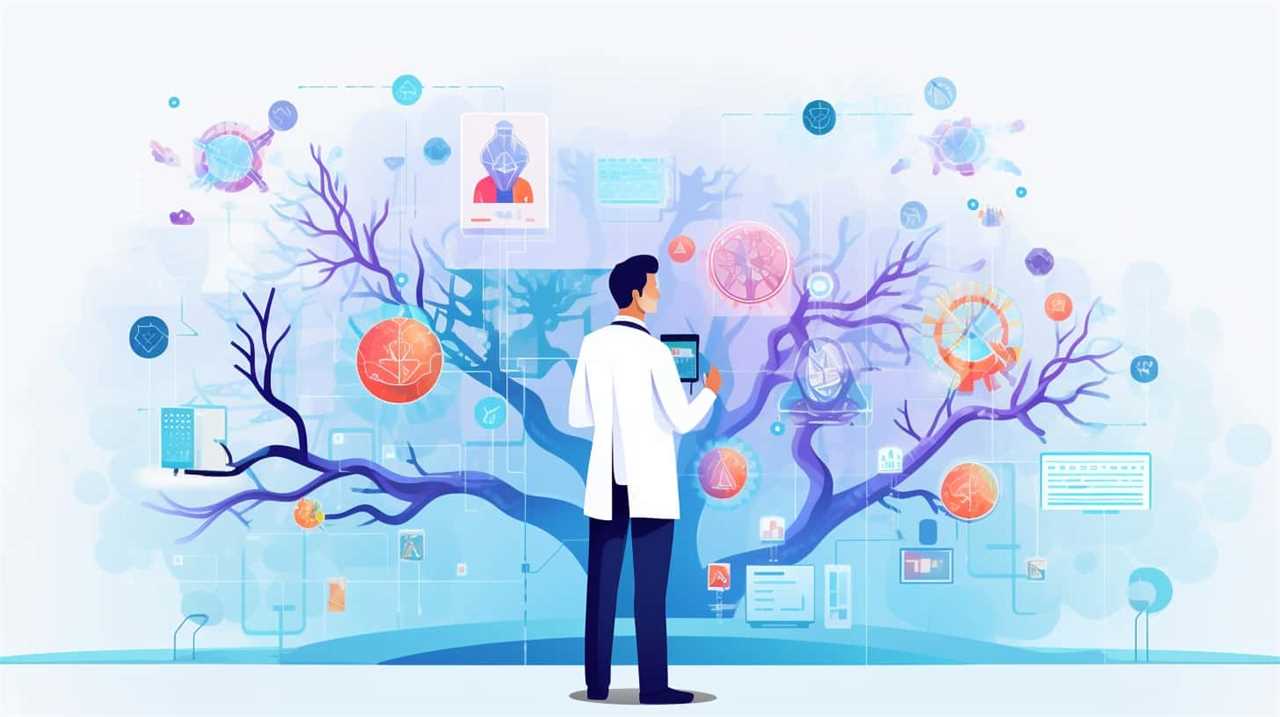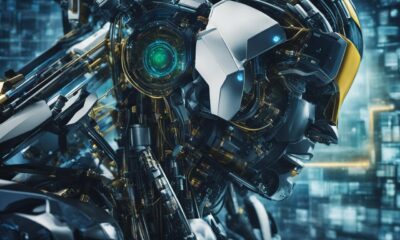AI News
AI Engineers Showcase Cutting-Edge AI Agents in SF Hackathon

As AI enthusiasts, we were filled with excitement, reminiscent of children in a candy store, at the recent hackathon in San Francisco, where top engineers showcased their cutting-edge AI agents.
From autonomous vehicle testing to real-time event monitoring and interactive experiences, the competition was fierce.
Driven by the power of neural networks, these agents pushed the boundaries of AI decision making.
Join us as we delve into the world of AI engineering and gain insights from the experts who participated in this groundbreaking event.

Innovation awaits!
Key Takeaways
- Engineers from around the world gathered in San Francisco to showcase state-of-the-art AI agents in a hackathon.
- The finalists included Auto Arena, Stim, Engagement Farmers, Spin-up, and Language Models Represent Space and Time paper.
- Dr. Jim Fan, a senior AI scientist at Nvidia, was involved in the development of the Minecraft Voyager AI model.
- There was a debate on the power and capabilities of neural networks in AI agent decision making.
Global Gathering of AI Engineers
We gathered engineers from around the world in San Francisco for the AI Engineers Competition.
This global gathering of AI engineers showcased the cutting-edge innovations and emerging AI trends in the global AI community.
The competition served as a platform for these engineers to showcase their expertise and push the boundaries of AI technology.

The event brought together top talent from various countries, fostering collaboration and knowledge-sharing among participants.
It was an opportunity to witness the latest advancements in AI and witness the potential for groundbreaking applications.
As we observed the presentations and demonstrations, it became evident that the global AI community is at the forefront of driving innovation and shaping the future of AI technology.
The competition highlighted the immense talent and dedication present in the AI engineering field, setting the stage for continued advancements and breakthroughs in the coming years.

State-of-the-Art AI Agents Compete
State-of-the-art AI agents competed in the SF Hackathon, showcasing their cutting-edge capabilities and pushing the boundaries of AI technology. These agents leveraged the latest neural network advancements to achieve remarkable feats in real-time event monitoring.
Here are four highlights from the competition:
- Auto Arena: Developed autonomous AI agents for rigorous testing.
- Stim: Created an AI agent specializing in real-time event monitoring.
- Engagement Farmers: Designed an AI agent that emulates Reddit-like interaction.
- Spin-up: Built an AI agent capable of generating comments.
These agents demonstrated the power of neural networks in analyzing and responding to complex events in real time.
The competition not only fostered innovation but also shed light on the exciting possibilities of AI in various domains, including autonomous systems, social media, and content generation.

Finalists and Their Innovative Agents
The finalists in the SF Hackathon showcased their innovative AI agents, pushing the boundaries of AI technology. These agents have the potential to greatly impact society and raise important ethical considerations in AI decision-making.
The Auto Arena team presented their autonomous AI agents, demonstrating the potential for self-driving cars to navigate complex road scenarios.
Stim showcased real-time event monitoring agents that can detect and respond to emergencies and critical situations.
Engagement Farmers presented AI agents capable of facilitating Reddit-like interactions, enabling users to engage in meaningful discussions and share relevant content.

Spin-up showcased agents that can generate comments, providing valuable insights and promoting engagement in online platforms.
Finally, the Language Models Represent Space and Time paper introduced agents with advanced language processing capabilities, opening up new possibilities for natural language understanding and communication.
These innovative agents have the potential to revolutionize various industries and society as a whole, but it’s crucial to consider the ethical implications of their decision-making processes.
Dr. Jim Fan’s Involvement in Minecraft Voyager
Dr. Jim Fan played a key role in developing the Minecraft Voyager AI model at the SF Hackathon. His involvement in this project brought valuable insights and expertise to the team.

Here are some notable aspects of his contribution:
- Dr. Jim Fan’s expertise: With his extensive knowledge in AI and deep learning, Dr. Fan provided valuable guidance and technical expertise throughout the development of the Minecraft Voyager AI model.
- Counterfactual reasoning: Dr. Fan’s contribution included implementing counterfactual reasoning techniques into the AI decision-making process. This approach allows the AI agent to consider alternative scenarios and make more informed decisions.
- Enhancing decision-making capabilities: Dr. Fan’s involvement focused on optimizing the AI model’s decision-making abilities by incorporating counterfactual reasoning. This approach enables the AI agent to anticipate and evaluate the potential outcomes of different actions.
- Advancing AI in gaming: Through his work on Minecraft Voyager, Dr. Fan contributed to the advancement of AI in gaming. The integration of counterfactual reasoning techniques in this AI model opens up new possibilities for intelligent and adaptive gameplay.
Exploring the Concept of World Models
During the SF Hackathon, we delved into the concept of world models, exploring their role in AI agent decision making.
World models serve as a core component in enabling AI agents to make informed decisions by predicting consequences, reasoning, planning, exploring, and avoiding mistakes.
These models have various applications in real-world scenarios, allowing AI agents to learn new skills and adapt to different environments.

However, the development of AI agents with world models also raises ethical considerations. The potential impact of these agents on society, privacy, and human autonomy must be carefully examined and regulated.
Striking a balance between innovation and responsible development is crucial to ensure the ethical deployment of AI agents with world models in the future.
AI Agents and Decision-Making Strategies
As we delve into AI Agents and their decision-making strategies, it’s important to consider the role of world models in guiding their actions and choices. World models serve as a core concept in AI agent decision making, enabling them to predict consequences, reason, plan, explore, and avoid mistakes.
In order to enhance decision-making capabilities, causal learning and active intervention are crucial. These strategies allow AI agents to understand cause-and-effect relationships and actively intervene in their environment to achieve desired outcomes. By incorporating causal learning, AI agents can make more informed decisions based on understanding the underlying factors influencing a situation.

Active intervention empowers AI agents to take deliberate actions to shape their environment and optimize decision-making processes. Together, these approaches enable AI agents to make smarter, more effective choices in a wide range of scenarios.
Insights From AI Experts’ Perspectives
Building upon our understanding of AI Agents and their decision-making strategies, let’s delve into the insights provided by AI experts’ perspectives.
In the realm of AI, causal learning and simulation play vital roles in the development of intelligent agents. By understanding the cause-and-effect relationships in their environment, AI agents can make more informed decisions and simulate potential outcomes.
Additionally, language models possess internal world models that enable them to comprehend and generate coherent text. These world models allow language models to understand context, make predictions, and generate responses that align with human-like understanding.

AI experts have highlighted the importance of incorporating causal learning, simulation, and language models’ internal world models into the decision-making processes of AI agents to enhance their capabilities and achieve more sophisticated and human-like performance.
Showcasing AI Models With World Modeling Capabilities
We showcased AI models with world modeling capabilities at the SF Hackathon. These models have the ability to predict consequences, reason, plan, explore, and avoid mistakes, making them highly valuable in decision-making processes.
Here are four key points about these AI models:
- Ethical implications: The use of world modeling in AI raises important ethical considerations. As these models become more sophisticated, it’s crucial to ensure that they’re used responsibly and in a manner that aligns with societal values.
- Applications in real-world scenarios: The applications of AI models with world modeling capabilities are vast. They can be used in various industries, such as healthcare, finance, and transportation, to make informed decisions, optimize processes, and improve outcomes.
- Improved decision-making: By incorporating world models into AI agents, decision-making processes can be enhanced. These models provide a deep understanding of the environment, enabling agents to make more accurate predictions and take optimal actions.
- Advancements in AI research: The development and demonstration of AI models with world modeling capabilities signify significant advancements in AI research. These models push the boundaries of what AI systems can achieve and pave the way for new innovations in the field.
Counterfactual Reasoning in AI Decision Making
Our exploration of AI models with world modeling capabilities continues as we delve into the realm of counterfactual reasoning in AI decision making.

Counterfactual reasoning refers to the ability of AI agents to reason about hypothetical scenarios and their potential outcomes, even if they haven’t occurred in reality. This capability allows AI agents to make informed decisions by considering alternative possibilities and their implications.
However, counterfactual reasoning in AI decision making also presents ethical implications, as it raises questions about the responsibility and accountability of AI agents in hypothetical scenarios. Furthermore, there are limitations and challenges in implementing counterfactual reasoning, such as the difficulty of accurately predicting the consequences of hypothetical actions and the potential biases that may arise.
Addressing these challenges is crucial to ensure the ethical and reliable use of counterfactual reasoning in AI decision making.
Predictions From AI Insider, Jimmy Apples
According to an AI insider, Jimmy Apples, the predictions for the future of AI include groundbreaking advancements in the field. Our analysis of Jimmy Apples’ predictions reveals several key insights:

- Counterfactual Reasoning: Jimmy Apples predicts that AI will make significant progress in counterfactual reasoning, enabling machines to simulate alternative scenarios and make more informed decisions.
- GPT 4 Announcement Date: Jimmy Apples claims to have insider knowledge about the exact date of the GPT 4 announcement, suggesting that this highly anticipated release will occur in the near future.
- Enhanced Natural Language Processing: Apples foresees major advancements in natural language processing, enabling AI systems to better understand and generate human-like text.
- Increased Automation: Apples predicts that AI will continue to drive automation across various industries, revolutionizing processes and enhancing productivity.
These predictions from Jimmy Apples offer a glimpse into the exciting future of AI, where machines will possess advanced reasoning capabilities, revolutionize language processing, and drive automation to new heights.
Conclusion
The showcase of cutting-edge AI agents at the SF hackathon was an awe-inspiring affair, with engineers from around the globe gathering to push the boundaries of artificial intelligence.
The diverse range of finalists displayed their innovative agents, demonstrating the power and capabilities of neural networks.
Dr. Jim Fan’s involvement in the Minecraft Voyager AI model added another layer of excitement to the event.

Through world modeling and counterfactual reasoning, these agents showcased their ability to make precise and analytical decisions.
The future of AI engineering looks promising with such advancements on display.
Bennett is the embodiment of versatility, adapting his writing to cover a broad spectrum of topics with professionalism and flair. Whether it’s breaking news, in-depth analyses, or feature pieces, Bennett’s contributions enrich Press Report with diverse perspectives and engaging content. His adaptability and keen journalistic instincts make him a vital member of our team, capable of capturing the essence of the moment in every story.
AI News
5 Examples of Technology Replacing Human Jobs
Discover how technology is reshaping the workforce in '5 Examples of Technology Replacing Human Jobs,' uncovering the profound impact on various industries.

The integration of technology into various industries has brought about major shifts in the job market, particularly in roles that used to be mainly held by humans. From manufacturing to customer service and retail, automation and artificial intelligence are now assuming tasks that were traditionally performed by people.
As advancements like self-driving technology, robotics, and self-service kiosks continue to redefine the way tasks are executed, the impact on employment patterns becomes increasingly pronounced.
The evolving relationship between technology and human labor prompts a critical examination of the future of work and the skills needed to adapt to this changing dynamic.
Key Takeaways
- Industrial robots like Baxter and Sawyer are transforming manufacturing processes.
- AI in customer service reduces costs and enhances efficiency through automation.
- Agricultural robots revolutionize farming with 24/7 efficiency and increased productivity.
- Self-service kiosks in retail streamline transactions, reducing the need for human cashiers.
Automation in Manufacturing
The increasing integration of computer-controlled robots in manufacturing processes is fundamentally reshaping the landscape of industrial production, displacing traditional human labor with more efficient and cost-effective automation solutions. Industrial robots such as Rethink Robotics' Baxter and Sawyer are at the forefront of this transformation, revolutionizing manufacturing by efficiently producing millions of unique products. The adoption of smarter and more affordable robots like these is on the rise in manufacturing processes, leading to a significant reduction in human labor and increased efficiency within the manufacturing sector.
Automation in manufacturing is not only streamlining production but also enhancing precision and consistency in tasks that were traditionally performed by assembly-line workers. These robots are capable of handling a wide range of functions, from simple repetitive tasks to complex operations, making them versatile assets on the factory floor. As the reliance on industrial robots continues to grow, the manufacturing industry is experiencing a shift towards a more automated and technology-driven future.
AI in Customer Service

Incorporating AI technologies into customer service operations is revolutionizing the way companies interact with their clients, shaping a more efficient and automated approach to handling inquiries and support services. AI technologies such as chatbots and virtual assistants are increasingly replacing traditional phone operators and customer service representatives, leading to significant cost savings for companies.
Automation in customer service not only improves response times and efficiency but also streamlines processes. Voice recognition and speech synthesis technologies play a crucial role in automating interactions with customers, reducing the need for human intervention and enhancing the overall customer experience.
- AI technologies like chatbots and virtual assistants are replacing phone operators and customer service representatives in various industries.
- Automation in customer service has led to significant cost savings for companies while improving response times and efficiency.
- Voice recognition and speech synthesis technologies are being used to automate interactions with customers, reducing the need for human intervention.
- Companies are increasingly adopting AI-powered systems to handle customer inquiries, complaints, and support services.
Robotics in Agriculture
As technology continues to advance across various industries, the integration of robotics in agriculture is rapidly transforming traditional farming practices. Agricultural robots are revolutionizing the farming industry by taking on tasks such as planting, harvesting, and weeding that were traditionally performed by humans. These robots offer the advantage of working 24/7, significantly increasing efficiency and productivity on farms. Automation in agriculture not only streamlines operations but also reduces the physical strain on workers, minimizing the need for manual labor.
Moreover, the implementation of precision agriculture techniques with robots leads to improved crop yields while simultaneously decreasing the reliance on pesticides and fertilizers. This shift towards robotics in agriculture signifies a significant technological advancement in the farming sector. As technology continues to progress, the adoption of agricultural robots is expected to grow further, enhancing the overall sustainability and productivity of the agricultural industry.
Self-Service Kiosks in Retail

With the rise of self-service kiosks in the retail sector, a notable shift towards automated transactions and reduced reliance on human cashiers is being observed. Retail stores are increasingly embracing self-service kiosks as part of their operations to enhance efficiency and customer convenience. These automated systems allow customers to scan and pay for items independently, minimizing the need for interaction with human staff. The implementation of self-service technology not only streamlines transactions but also caters to the growing demand for quick and seamless shopping experiences.
Key Points:
- Self-service kiosks in retail stores have decreased the requirement for human cashiers.
- Customers can scan and pay for items independently, reducing the need for staff interaction.
- Retailers adopt self-service technology to streamline transactions and enhance efficiency.
- Self-service kiosks offer convenience by handling multiple transactions simultaneously.
Drones in Delivery Services
The integration of drones into delivery services is revolutionizing the efficiency and speed of transporting packages, especially in remote areas, as companies like Amazon lead the way in testing and implementing drone delivery systems.
Drones have become a crucial part of logistics operations, offering an efficient and automated solution for delivering goods to even the most isolated locations. By utilizing drones, companies can significantly reduce delivery times and costs, making the transportation industry more streamlined and cost-effective.
Automated drones are capable of reaching destinations faster than traditional delivery methods, showcasing their potential to transform the way packages are transported. This shift towards drone delivery services is reshaping the industry, with businesses recognizing the value of incorporating this innovative technology into their operations.
As drones continue to evolve and improve, they are poised to become a cornerstone of modern delivery services, offering a glimpse into a future where speed and efficiency are paramount in the transportation of goods.
Frequently Asked Questions
Which Jobs Are Being Replaced?
The evolving landscape of job roles is witnessing a transformation where technological advancements are replacing traditional human jobs across various sectors. This shift is evident in roles such as cashier, phone operator, data entry worker, lift operator, and switchboard operator.
What Machine Has Replaced Human Labor?
Efficiency-enhancing machines like automated pin-setting machines in bowling alleys, digital printing technology in the printing industry, and packaging machines in industries have replaced human labor, optimizing processes, cutting costs, and boosting productivity.
What Technology Is Replacing Manual Labor?
Automation technology is gradually replacing manual labor across various industries, enhancing efficiency and accuracy. By utilizing computer-controlled systems and robots, tasks that were traditionally done by hand are now being performed with precision and speed.
What Other Once Human Jobs Are Done Now by Technology?
In today's rapidly evolving landscape, technology continues to redefine the workforce. Various traditional roles, once performed by humans, are now seamlessly executed by machines, demonstrating the transformative power of innovation in our modern economy.
Conclusion
In conclusion, the integration of technology in various industries has led to the replacement of human jobs with automation and robotics. According to a recent study by the World Economic Forum, it is projected that by 2025, automation will displace 85 million jobs globally in sectors such as manufacturing, transportation, customer service, retail, and agriculture.
This shift towards technology-driven solutions highlights the need for upskilling and reskilling of the workforce to adapt to the changing job market landscape.
Ava combines her extensive experience in the press industry with a profound understanding of artificial intelligence to deliver news stories that are not only timely but also deeply informed by the technological undercurrents shaping our world. Her keen eye for the societal impacts of AI innovations enables Press Report to provide nuanced coverage of technology-related developments, highlighting their broader implications for readers.
AI News
How AI Will Replace Creative Jobs: A Guide
Witness the transformative power of AI on creative jobs, provoking thought on the future of artistic professions.

In a time where rapid technological advancements are constantly changing industries, the important question of how AI impacts creative jobs remains a pressing concern for many professionals.
The convergence of artificial intelligence and creativity has sparked debates on the future of roles that were once thought to be immune to automation.
As we navigate this transformative landscape, it becomes essential to explore the potential implications, challenges, and strategies for those in creative fields.
Join us as we navigate the intricate interplay between AI and creative jobs, uncovering the potential disruptions and opportunities that lie ahead.
Key Takeaways
- Embracing AI enhances creativity and productivity in creative industries.
- Collaboration between AI and humans drives innovation and new opportunities.
- AI automates tasks but increases demand for human creative input.
- Adapting to AI integration is essential for future success in creative roles.
Impact of AI on Creative Industries
Embracing the transformative power of AI, the creative industries are witnessing a paradigm shift in the way tasks are automated and creativity is augmented. The integration of AI technologies is poised to revolutionize creative jobs by automating approximately 26% of tasks in arts, design, entertainment, media, and sports industries. While AI advancements bring advanced capabilities to marketing content creation, impacting advertising campaigns positively, concerns about job displacement loom on the horizon. Companies are actively exploring AI's value in creative industries, with McKinsey identifying significant opportunities in product development, marketing, and enhancing customer experiences.
The impact of AI on creative work is multifaceted, offering both opportunities and risks. The efficient implementation of AI tools can streamline processes, increase productivity, and enhance creativity. However, the potential for job displacement underscores the importance of managing ethical considerations and preparing for potential disruptions in the workforce. As AI continues to evolve, navigating the balance between leveraging its benefits and mitigating its challenges will be crucial in shaping the future of the creative industries.
Reshaping the Creative Workforce

The evolution of AI technologies is fundamentally reshaping the composition and dynamics of the creative workforce in unprecedented ways. As generative AI tools like ChatGPT and Midjourney continue to advance, the future of creative professions is being redefined. These artificial intelligence (AI) applications challenge traditional perceptions of creativity as solely human, with the potential to automate a significant 26% of tasks in industries such as arts, design, entertainment, media, and sports.
| Impact on Creative Workforce | ||
|---|---|---|
| Positive Aspects | Challenges | Future Implications |
| – Streamlining repetitive tasks | – Fear of job displacement | – Collaboration between AI and humans |
| – Enhanced creativity potential | – Need for upskilling | – New job roles focusing on AI integration |
| – Increased productivity | – Maintaining originality | – Shift towards hybrid skill sets |
The rise of generative AI is not just altering how work is done but also creating a demand for uniquely human creative inputs in the face of the influx of AI-generated content. Looking ahead, the creative workforce must adapt to a landscape where the synergy between AI and human creativity will drive innovation and new opportunities.
Adaptation Strategies for Creative Professionals
In the rapidly evolving landscape of the creative industry, strategic adaptation to AI technologies is essential for professionals seeking to thrive and lead in the future of creative work. Embracing AI tools, integrating them into creative workflows, and enhancing decision-making processes are key strategies for creative professionals looking to stay ahead in a rapidly changing environment.
Adaptation Strategies:
- Embrace AI Tools: Utilize AI tools to enhance productivity and creativity.
- Integrate AI into Workflows: Incorporate AI into creative processes for more efficient and effective outcomes.
- Enhance Decision-making: Use AI to make data-driven decisions and streamline processes.
- Focus on High-level Work: Let AI handle routine tasks, allowing professionals to focus on high-level creative work.
Challenges Posed by AI in Creative Jobs

Navigating the integration of AI technologies into creative roles presents a myriad of challenges that require strategic foresight and adaptability from professionals in the industry. With generative AI predicted to automate 26% of tasks in arts, design, entertainment, media, and sports industries, concerns have arisen about AI-generated content saturating markets and potentially displacing human creatives. The delicate balance between AI automation and human creativity is paramount in steering the course of creative jobs amidst this technological revolution.
AI applications such as ChatGPT and Midjourney exemplify the transformative potential within creative industries, showcasing both the capabilities and the looming challenges that AI brings. As generative AI continues to evolve, the economic landscape of creative jobs is also shifting, giving rise to the thriving creator economy and presenting new opportunities for monetizing creative work.
To thrive in this evolving environment, creative professionals must embrace innovation, hone their unique creative skills, and find ways to collaborate effectively with AI technologies to stay ahead in the ever-changing realm of creative jobs.
Future Outlook for Creative Careers
Amidst the evolving landscape of creative industries impacted by AI advancements, the future outlook for creative careers necessitates a proactive embrace of innovation and adaptability to harness emerging opportunities. As we navigate the intersection of creativity and artificial intelligence, several key considerations shape the future of work in creative fields:
- Harvard Business Review Insights: According to the Harvard Business Review, understanding how AI models can augment creative processes will be crucial for professionals in creative careers.
- Adaptation to AI Models: Embracing AI models like GPT-3 and DALL-E 2 will be essential for enhancing efficiency and exploring new creative possibilities.
- Reskilling and Upskilling: Investing in continuous learning and upskilling efforts will empower creatives to stay ahead in an AI-dominated landscape.
- Collaboration with Technology: Fostering collaborations between creatives and AI technologies can lead to innovative breakthroughs and redefine the boundaries of creativity in the digital age.
Frequently Asked Questions
Will AI Replace Creative Professions?
AI's rapid evolution raises questions on the future of creative professions. As technology advances, highly-skilled knowledge workers might face job displacement. The impact of AI on creative jobs is a critical concern demanding proactive strategies and adaptability.
How Will AI Affect the Creative Industry?
AI is reshaping the creative industry by streamlining tasks, enhancing productivity, and fostering innovation. As AI automates processes in arts, design, entertainment, media, and sports, companies are leveraging its potential in product development, marketing, and customer experience for competitive advantage.
How Can Artificial Intelligence Be Used in Creative Jobs?
Artificial intelligence revolutionizes creative jobs by enhancing ideation, automating tedious tasks, and producing intricate designs swiftly. From transforming sketches into realistic visuals to providing design elements, AI optimizes workflows, empowering creatives to focus on innovation.
What Jobs Will AI Eventually Replace?
AI will replace routine tasks across various industries, impacting roles like data entry, customer service, and repetitive manufacturing jobs. Highly analytical professions such as financial analysis and medical diagnostics are also susceptible to AI integration.
Conclusion
In the ever-evolving landscape of creative industries, the rise of AI poses a formidable challenge to traditional creative roles.
As AI technology continues to advance, the need for creative professionals to adapt and innovate becomes increasingly crucial.
The future of creative careers lies in embracing and harnessing the power of AI to enhance, rather than replace, human creativity.
By navigating this shifting paradigm with foresight and ingenuity, creative professionals can carve out new pathways to success in the digital age.
Ava combines her extensive experience in the press industry with a profound understanding of artificial intelligence to deliver news stories that are not only timely but also deeply informed by the technological undercurrents shaping our world. Her keen eye for the societal impacts of AI innovations enables Press Report to provide nuanced coverage of technology-related developments, highlighting their broader implications for readers.
AI News
10 Best Jobs Robots Cannot Replace
Glimpse into the future of work with the 10 Best Jobs Robots Cannot Replace, uncovering the unique human skills essential in an automated world.

In a world constantly shaped by technological advancements, the question of which jobs are immune to automation becomes increasingly important.
As we navigate the realm of artificial intelligence and machine learning, certain professions persist as bastions of uniquely human capabilities that robots cannot replicate. From healthcare providers offering compassionate care to the intricate decision-making of judges, the list of roles that require human touch and judgment is intriguingly diverse.
Let's explore the nuances of these vital occupations that continue to defy automation's reach and underscore the enduring value of human skills in an automated world.
Key Takeaways
- Healthcare professionals offer personalized care AI cannot replicate.
- Social workers provide tailored support with human insight and adaptability.
- Musicians create emotional connections through unique human expression.
- Leadership roles require emotional intelligence, adaptability, and employee engagement skills.
Healthcare Professionals
Healthcare professionals, possessing a unique blend of intricate human skills essential for patient care, stand as irreplaceable assets in the realm of healthcare. Among these professionals, surgeons play a pivotal role, requiring a combination of precision, empathy, and critical decision-making abilities. Their years of training and expertise enable them to perform intricate surgeries that demand not only technical skill but also human judgment and dexterity. Unlike artificial intelligence (AI), surgeons possess emotional intelligence and intuition crucial for navigating the complexities of patient care.
Furthermore, nurses and doctors also form an integral part of the healthcare team, engaging in nuanced communication and empathy vital for patient interactions. The dynamic and unpredictable nature of healthcare settings underscores the necessity of human intervention and adaptability, qualities that AI cannot replicate. While technology continues to advance, the human touch provided by healthcare professionals remains unparalleled in ensuring comprehensive and compassionate patient care. In a field where empathy and skill intertwine, healthcare professionals continue to excel as irreplaceable pillars of support and healing.
Therapists and Counselors

Amid the technological advancements of AI and automation, the role of therapists and counselors stands as a beacon of human connection importance and emotional support essential in today's society.
These professionals offer a level of personalized care and empathy that transcends mere problem-solving, creating deep emotional connections vital for mental health treatment.
The nuanced human interactions and tailored solutions provided by therapists highlight the irreplaceable essence of their work in fostering healing and growth.
Human Connection Importance
In the realm of mental health services, the significance of human connection in therapy cannot be overstated.
Therapists and counselors play a vital role in providing emotional support through empathy and active listening, skills that are uniquely human and essential for effective therapy. Unlike AI, human therapists have the ability to establish genuine connections with clients, building trust and creating a safe environment for individuals to express their thoughts and feelings openly.
The capacity to understand and address the specific needs of each client on a personal level sets human therapists apart from artificial intelligence. The therapeutic relationship thrives on human qualities like compassion and understanding, making therapists indispensable in providing personalized emotional support that AI cannot replicate.
Emotional Support Essential
The provision of emotional support by therapists and counselors is foundational in guiding individuals through mental health challenges and fostering their overall well-being. Human therapists possess a unique ability to empathize and connect with clients on a deep emotional level, a skill AI lacks. This human touch is crucial in helping individuals navigate personal struggles and develop effective coping strategies.
The therapeutic relationship built on trust and understanding is a hallmark of human therapy, offering a level of personalized care that cannot be replicated by machines. By promoting mental well-being through tailored interventions and compassionate support, therapists play a vital role in enhancing the lives of those they serve.
Social Work and Community Outreach
With their unique blend of empathy and emotional intelligence, social workers and community outreach professionals play a vital role in supporting individuals and communities in need. These roles require a human touch that cannot be replicated by AI, as they involve building trust, fostering relationships, and providing personalized care. Social workers address complex social issues and advocate for vulnerable populations, relying on deep understanding and connection with people.
Community outreach workers collaborate with diverse groups to address community needs and promote social change, demanding human insight and adaptability. The human touch in social work and community outreach is essential for effective support, empowerment, and advocacy for individuals and communities.
Social work and community outreach roles require human empathy and emotional intelligence. Building trust, fostering relationships, and providing personalized care are essential in these professions. Advocacy for vulnerable populations and addressing community needs demand human insight and adaptability.
Musicians

Musicians possess a unique ability to convey creative expression through music, establishing an emotional connection with their audience that AI struggles to replicate. Their interpretations are deeply personal, requiring intuition and sensitivity that machines lack.
The nuanced artistry of musicians, including improvisation and personalized renditions, remains a distinctly human skill that cannot be replaced by artificial intelligence.
Creative Expression in Music
Elevating the human experience through the power of melody and emotion, musicians embody the essence of creative expression in music. Musicians infuse their work with emotional depth, intertwining storytelling with a personal touch that resonates deeply with listeners. Through their human intuition, musicians can craft intricate melodies and harmonies that convey complex emotions beyond the capabilities of AI.
Their ability to innovate and interpret music adds a unique flair to each performance, creating a profound connection with their audience. This connection is a testament to the irreplaceable role musicians play in the realm of creative expression, where the intricacies of human emotion and storytelling find their most authentic form.
- Musicians bring unique creative expression and emotional depth to their music that AI cannot replicate.
- The artistry and interpretation in music performances require human intuition and personal touch.
- Musicians excel in conveying complex emotions and storytelling through their music.
Emotional Connection With Audience
The emotional resonance between musicians and their audiences during live performances is a profound testament to the power of human connection through music. Musicians have the ability to tap into deep human experiences, creating a shared experience that transcends the boundaries of language.
Through their personal touch and authenticity, they forge a bond with listeners that goes beyond mere entertainment. Music performances are not just about playing notes; they are about evoking emotions, stirring memories, and touching hearts.
The unique blend of creativity and passion in each performance allows for a genuine connection that AI cannot replicate. This emotional connection is what makes live music so special and irreplaceable in the realm of artistic expression.
Unique Musical Interpretation
With their innate ability to infuse music with personal interpretation and creative flair, human musicians bring a unique depth to their performances that sets them apart from artificial intelligence counterparts. Musicians excel in creativity, improvisation, and connecting with audiences on a personal level. Their emotional depth and nuanced expressions evoke a sense of authenticity that resonates deeply with listeners.
Additionally, human musicians contribute significantly to the cultural richness and diversity of musical expressions worldwide. The artistry and authenticity of live performances further highlight the irreplaceable nature of human musicians in the realm of music, showcasing their ability to evoke emotions and create memorable experiences that transcend technological capabilities.
High-Level Strategists and Analysts

Strategists and analysts at the highest level play a pivotal role in shaping the strategic direction and decision-making processes of organizations across diverse industries. These professionals are adept at data analysis, critical thinking, and interpreting data to provide creative solutions and accurate forecasting. Their ability to make sense of complex information and apply it strategically is a skill that AI struggles to replicate effectively. High-level strategists and analysts are crucial for identifying opportunities and risks within industries by analyzing trends, market conditions, and competitor activities. Their human expertise allows them to adapt plans and strategies dynamically, a task that requires intuition and creativity beyond the capabilities of artificial intelligence.
| Skills | Description |
|---|---|
| Data Analysis | Analyzing and interpreting large datasets |
| Critical Thinking | Evaluating information objectively |
| Forecasting | Predicting future trends accurately |
| Creative Solutions | Providing innovative problem-solving approaches |
Research Scientists and Engineers

Embodying the spirit of innovation and discovery, research scientists and engineers stand at the forefront of advancing scientific knowledge and technological breakthroughs. Their tireless efforts contribute significantly to breakthrough discoveries across various fields, including medicine, technology, and environmental science.
Here are some key aspects that highlight the importance of research scientists and engineers:
- Critical Role: Research scientists and engineers play a crucial role in pushing the boundaries of scientific knowledge through their experiments and studies.
- Innovative Solutions: Their work involves designing and conducting experiments, analyzing vast amounts of data, and developing innovative solutions to complex problems.
- Shaping the Future: By driving progress and shaping the future of society, research scientists and engineers are instrumental in developing technologies that improve lives and enhance our understanding of the world.
With their expertise and dedication, these professionals continue to be indispensable in driving advancements and shaping the world we live in through their relentless pursuit of knowledge and innovation.
Performing Arts

The realm of Performing Arts captivates audiences worldwide with its unparalleled blend of human emotion, creativity, and artistic expression. Professional dancers and theatre artists possess a level of expressions, agility, and precise movements that AI cannot replicate. The choreography of a dance piece or the direction of a play requires a personal touch and creativity that is inherently human. Emotion plays a crucial role in performing arts, as artists convey feelings and messages through their performances, connecting with audiences on a deep level. The intricacies of live performances, the improvisation, and the ability to adapt to the audience's reactions are skills that remain exclusive to human performers. The creativity and innovation that artists bring to their craft set them apart from automation by AI, making the world of performing arts a realm where human ingenuity shines brightly.
| Expressions | Agility | Movements |
|---|---|---|
| Human artists | Precision | Choreography |
| Emotion | Personalized | Interpretation |
| Connection | Adaptability | Creativity |
Judges

In the realm of legal adjudication, the role of judges stands as a pinnacle of human intellect, emotional acumen, and ethical discernment. When it comes to the field of law, judges play a critical role in ensuring justice is served through their unique set of skills and capabilities:
- Legal Reasoning: Judges require complex legal reasoning, argumentation, and understanding of nuanced legal situations to make sound judgments.
- Emotional Intelligence: Human judges possess emotional intelligence crucial for navigating intricate legal matters, understanding the nuances of human behavior, and making empathetic decisions.
- Legal Ethics and Moral Judgment: Legal ethics and moral judgment are essential qualities for judges to uphold the integrity of the legal system and make decisions that are just and fair.
Furthermore, the dynamic nature of law demands human interpretation and judgment, allowing judges to excel in strategizing and adapting legal strategies to the unique circumstances of each case.
Leadership and Management Roles

In the realm of leadership and management roles, the essence lies in strategic decision-making skills, team building expertise, and visionary leadership qualities. These attributes are intrinsically human, requiring a blend of cognitive acumen, emotional intelligence, and adaptability.
As technology advances, the distinct human touch in leadership becomes increasingly invaluable, making these roles imperative in driving organizational success and fostering innovation.
Strategic Decision-Making Skills
With the rise of automation and artificial intelligence in the business world, the irreplaceable essence of strategic decision-making skills in leadership and management roles becomes increasingly evident. In leadership positions, human intuition, emotional intelligence, and the ability to navigate uncertain situations play a pivotal role in guiding organizations towards success.
The following highlights the key aspects that make strategic decision-making skills indispensable in leadership and management roles:
- Human intuition and emotional intelligence
- Navigating uncertain situations with finesse
- Utilizing data-driven insights for informed decisions
These abilities are essential for leaders to not only survive but thrive in dynamic and unpredictable business environments, where AI falls short in providing the necessary depth and understanding.
Team Building Expertise
Demonstrating adeptness in cultivating synergistic relationships within teams is an indispensable skill set for individuals in leadership and management roles. Human expertise in team building involves recognizing individual strengths, promoting effective communication, and skillfully resolving conflicts.
Emotional intelligence plays a crucial role in fostering trust and motivation among team members, leading to improved collaboration and enhanced job satisfaction. Successful team building efforts not only boost productivity and creativity but also contribute to creating a positive work environment where employees feel valued and empowered.
Leaders who excel in team building showcase strong leadership abilities that inspire and guide their teams towards achieving common goals with a sense of unity and purpose.
Visionary Leadership Qualities
Exemplifying visionary leadership qualities is essential for individuals in leadership and management roles, encompassing strategic foresight, innovative thinking, and adaptable decision-making.
- Strategic Planning: Visionary leaders develop long-term goals, set clear objectives, and create roadmaps to achieve organizational success.
- Innovation: Embracing creativity and fostering a culture of innovation allows visionary leaders to stay ahead of the competition and drive continuous improvement.
- Adaptability: Being able to pivot in response to changing environments, technologies, and market conditions is crucial for visionary leaders to lead their teams effectively.
Human leaders bring emotional intelligence, ethical considerations, and the ability to inspire and motivate teams, setting them apart from automation in driving organizational growth and shaping the future direction of their organizations.
Human Resources and Talent Acquisition

In the realm of business operations, Human Resources and Talent Acquisition stand as irreplaceable facets that hinge on the intricate balance of human judgment, emotional intelligence, and empathy.
Human Resources professionals are pivotal in fostering employee engagement, retention, and overall organizational development. They navigate the complexities of human behavior, motivations, and cultural dynamics within a company to ensure a harmonious work environment.
On the other hand, Talent Acquisition Specialists play a crucial role in sourcing, screening, and selecting top-tier candidates who align with the organization's needs and values. These roles demand a deep understanding of human psychology and the ability to build strong relationships with both employees and potential hires.
While AI technologies have streamlined certain aspects of recruitment, they cannot replicate the nuanced interpersonal skills and emotional connections that are essential in Human Resources and Talent Acquisition roles. The human touch remains irreplaceable in these critical functions of workforce management.
Frequently Asked Questions
What Jobs Cannot Be Replaced by Robots?
Jobs that require complex decision-making, critical thinking, ethical considerations, human emotions, empathy, social intelligence, creativity, innovation, artistic expression, physical dexterity, agility, precise movements, nuanced communication, intuition, and human judgment are areas where robots struggle to replace human capabilities.
Which Jobs Are in Danger Due to Ai?
Roles at risk due to AI advancements include telemarketers, bookkeeping clerks, receptionists, sales professionals, market researchers, advertising salespeople, retail sales staff, proofreaders, computer support specialists, couriers, compensation and benefits managers. Automation threatens to displace these positions through streamlined processes and cost-effective solutions.
What Jobs Will Be Gone by 2030?
By 2030, jobs vulnerable to automation include roles like agricultural equipment operators, heavy truck drivers, vocational teachers, and machinery repairers. As AI advancements evolve, positions requiring human judgment, emotional intelligence, creativity, and physical dexterity remain less susceptible to displacement.
Which Jobs Will Not Disappear in the Future?
In the evolving landscape of work, roles demanding intricate decision-making, creativity, interpersonal skills, strategic thinking, critical analysis, and innovation will endure. These professions rely on uniquely human qualities that AI cannot replicate, ensuring their longevity in the future job market.
Conclusion
In conclusion, the irreplaceable nature of certain jobs by robots underscores the enduring value of human skills and qualities in the workforce.
As technology continues to advance, it is crucial to recognize the importance of roles that rely on emotional intelligence, creativity, critical thinking, and human interaction.
These professions not only provide essential services but also highlight the unique capabilities that distinguish humans from machines in the ever-changing landscape of automation.
Ava combines her extensive experience in the press industry with a profound understanding of artificial intelligence to deliver news stories that are not only timely but also deeply informed by the technological undercurrents shaping our world. Her keen eye for the societal impacts of AI innovations enables Press Report to provide nuanced coverage of technology-related developments, highlighting their broader implications for readers.
-

 AGI and AI Impact on Human Relationships6 days ago
AGI and AI Impact on Human Relationships6 days agoIs the Threat of AI Overblown? Unpacking Myths
-

 AI in Business3 weeks ago
AI in Business3 weeks agoAI at Work Beyond Cloud Cuts Company Costs
-

 AGI and AI Impact on Human Relationships2 weeks ago
AGI and AI Impact on Human Relationships2 weeks agoAGI and AI’s Effect on Human Relationships
-

 AGI and AI Impact on Human Relationships1 day ago
AGI and AI Impact on Human Relationships1 day agoIs AGI a Threat to Humanity? Explore the Risks
-

 AGI and AI Impact on Human Relationships3 weeks ago
AGI and AI Impact on Human Relationships3 weeks agoImpact of Artificial Intelligence on Humanity
-

 AGI and AI Impact on Human Relationships3 weeks ago
AGI and AI Impact on Human Relationships3 weeks ago1X Technologies Androids Built to Benefit Society
-

 AGI and AI Impact on Human Relationships2 weeks ago
AGI and AI Impact on Human Relationships2 weeks agoAI’s Influence on Society: Insights & Outlook
-

 AGI and AI Impact on Human Relationships2 weeks ago
AGI and AI Impact on Human Relationships2 weeks agoConsequences of Reaching AGI Unveiled
















